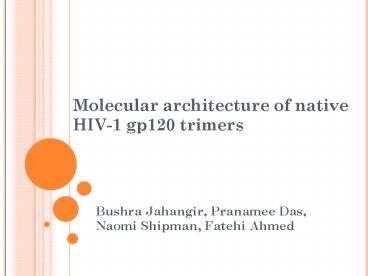Molecular architecture of native HIV1 gp120 trimers
1 / 11
Title: Molecular architecture of native HIV1 gp120 trimers
1
Molecular architecture of native HIV-1 gp120
trimers
- Bushra Jahangir, Pranamee Das, Naomi Shipman,
Fatehi Ahmed
2
Introduction
- Human Immunodeficiency Virus (HIV) is thought to
have evolved from the Simian Immunodeficiency
Virus (SIV). - gt 33 million people worldwide are infected with
HIV, making it a global epidemic. - Has very high mutation rate hence immune system
cannot keep up with it. - Clear understanding of viral structure is
fundamental for vaccine development.
3
Introduction
- Envelope glycoproteins (Env) are heterodimers of
- a transmembrane glycoprotein gp41.
- a surface glycoprotein gp120.
- Form trimers on surface of viral membrane.
- Facilitate viral binding to CD4 receptor on
target lymphocytes to initiate infection.
4
Methods
- Incubated viral suspension with/without Fab
fragment b12 or CD4 Fab fragment 17b. - CD4 binding replicates in vivo HIV-1 entry.
- b12 used as a neutralising antibody.
- 17b used to stabilise interaction with CD4.
5
Methods
- X-ray crystallography Cryo-electron tomography
(CET). - colloidal gold used in tagging, prior to CET.
- both methods combined allowed visualisation of
conformational changes. - Mapping of co-ordinates based on CET spikes using
Chimera software. - density maps derived from CET, crystallography
and Chimera. - combination of methods provides a powerful
approach to discern key elements of the structure
e.g. V1/V2 and V3 loops.
6
Results
- 3D structure of Env in both liganded unliganded
states has been elucidated. - CD4 binding causes gp120 rotation and discernible
changes to gp41. - exposes V3 loop.
7
Results
- b12 binding locks gp120 in the Env trimer.
- averts further conformational change.
- prevents exposure of V3 loop.
- stops rearrangement of gp41.
- inhibits viral entry into host target cell.
8
Conclusion
- Knowing the 3D conformational change is important
for understanding viral entry. - Methods elucidated the 3D structure of the Env
trimer in its different conformational states as
dictated by specific ligand binding. - unliganded.
- b12 - bound.
- CD4/17b - bound.
9
Conclusion
- CD4/17b binding induces dramatic structural
changes to Env trimer in comparison to the b12
antibody. - gp120 rotation displacement.
- gp41 rearrangement.
- exposure of V3 loop and other antigenic
determinants leads to contact between viral and
target cell membranes. - This is the first study to generate 3D images of
the intact Env trimer in its different
conformational states. - HIV-1 stalk region (gp41) identified in this
study resembles SIV stalk region determined in
previous studies.
10
Further Study
- Investigate further the structural changes in an
attempt to design drugs, which inhibit the
conformational change thus preventing viral
entry. - use small angle X-ray scattering (SAXS) to detect
structural changes in the viral proteins. - generates X-ray scattering curves.
- Understand mechanisms of antibody binding to Env
that lead to viral neutralisation.
11
References
- Fig 1 HIV prevalence map. http//www.contraboli.r
o/stuff/p/epidemia-hiv.png. Accessed on
25/02/2009. - Liu, J et al. Molecular architecture of native
HIV-1 gp120 trimers. Nature 455, 109-U76 (2008).































